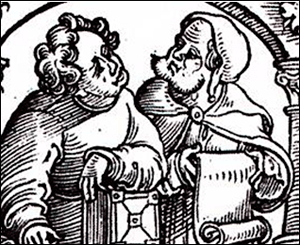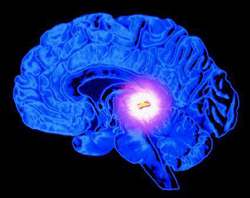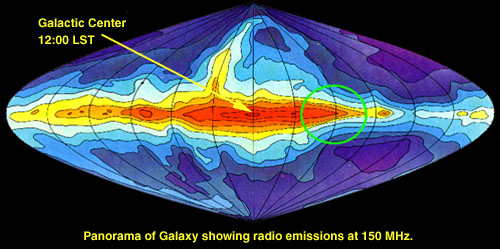Dear Friends,
Click the link to view the images/access the links/videos.
http://www.viewzone.com/pineal.html
Be Well.
David By Gary Vey  After writing several articles on reincarnation and enlightenment, many readers asked me why I never mentioned the significance of the pineal gland -- a small structure about the size of a pea, located in the middle of the brain. For centuries this gland has been thought of by occultists and spititual masters as the "seat of the soul" -- a phrase made popular by Descartes (1662 AD).
After writing several articles on reincarnation and enlightenment, many readers asked me why I never mentioned the significance of the pineal gland -- a small structure about the size of a pea, located in the middle of the brain. For centuries this gland has been thought of by occultists and spititual masters as the "seat of the soul" -- a phrase made popular by Descartes (1662 AD)."Although the soul is joined with the entire body, there is one part of the body [the pineal] in which it exercises its function more than elsewhere... [The pineal] is so suspended between the passages containing the animal spirits [guiding reason and carrying sensation and movement] that it can be moved by them...; and it carries this motion on to the soul ... Then conversely, the body machine is so constituted that whenever the gland is moved in one way or another by the soul, or for that matter by any other cause, it pushes the animal spirits which surround it to the pores of the brain." -- Descartes
The Pineal Gland in History Although commonly attributed to Descartes, the idea that the pineal gland was the interfacing organ where the spirit of man gained access and animated the human body was the idea of a Greek physician named Herophilus. Three hundred years before Christ, Herophilus [right] was dissecting corpses and documenting what he observed. His specialties were the reproductive system and the brain.  Prior to Herophilus, people believed the "executive office" of human consciousness was the heart. Egyptian mummies had their hearts carefully embalmed and preserved while their brains were removed through their nasal passages and unceremoniously discarded. But Herophilus knew that the brain was the controlling center and he went on to discriminate between the various parts of the brain and assess the different behaviors associated with them. Prior to Herophilus, people believed the "executive office" of human consciousness was the heart. Egyptian mummies had their hearts carefully embalmed and preserved while their brains were removed through their nasal passages and unceremoniously discarded. But Herophilus knew that the brain was the controlling center and he went on to discriminate between the various parts of the brain and assess the different behaviors associated with them. Herophilus noticed that the small pineal structure was singular, unlike other brain features that are mirrored in the left and right hemispheres. It is the first gland to be formed in the foetus and is distinguishable at 3 weeks. It is also highly nourished. The pineal gland has been supplied with the best blood, oxygen and nutrient mix available in the human anatomy, second only to that of our kidneys (whose function is to filter the blood of impurities). Because of this unique and special anatomical configuration, Herophilus rightly concluded it had a major role in consciousness and was the gateway to our real self. Herophilus is credited with the "invention" of the scientific method, the dogma of just about every scientific inquiry today, which consists of postulating theories and conducting experiments to prove or disprove them. It is ironic then that scientific inquiry of the pineal gland has been vigorously avoided because of its association with "spiritual" phenomena -- incapable of empirical scrutiny. Only recently have scientists become interested in knowing more about this mysterious gland. Herophilus wrote many volumes about anatomy and illustrated them, much as Leonardo Da Vinci did centuries later, but sadly his work did not survive the destruction of the great library in Alexandria where they were stored. The Third Eye By 1884, the field of comparative anatomy was revealing evidence that human organs could be traced back to lower vertebrates. F. Ahlborn recognized that pineal gland was originally a photoreactive organ in fish and amphibians and was sometimes located outside the skull, just under the skin. Its function as a trigger for reproduction was noted some 70 years later. The pineal gland was responsible for evaluating the length of day and night, calculating the correct season to mate and turning up the sex drive.  By 1958, Aaron Lerner discovered melatonin, a vital molecule produced in the pineal gland from another common neurotransmitter, serotonin. He also validated the fact that the production of melatonin varied, stopping during the daylight and ramping up shortly after darkness. Melatonin, it was learned, was responsible for making us relaxed and putting us to sleep. By 1958, Aaron Lerner discovered melatonin, a vital molecule produced in the pineal gland from another common neurotransmitter, serotonin. He also validated the fact that the production of melatonin varied, stopping during the daylight and ramping up shortly after darkness. Melatonin, it was learned, was responsible for making us relaxed and putting us to sleep. For a while it was not known how this small gland, buried deep in the middle of human brain, could sense light or darkness. But it was later discovered that there was a link to the pineal gland from the retinas which, oddly enough, also contained melatonin. In no time the pineal gland was being called "the third eye" and, because of its location at one of the seven chakras, it was reputed to be the center of spiritual and psychic energy. As hallucinogens became popular in the late 1960s, interest in altered states of consciousness, as a means to spirituality, peaked. Researchers discovered that LSD became highly concentrated in the pineal and pituitary glands. The altered state was produced by LSD's ability to imitate serotonin at the synapse (where the neurons communicate with each other). Since both serotonin and melatonin are also concentrated in the pineal gland, this "third eye" was considered a portal to consciousness -- what author Alduos Huxley called "the door of perception."  Even Gurus have commented on the pineal, equating it to one of the chakras: Even Gurus have commented on the pineal, equating it to one of the chakras: "All psychic systems have their physical aspects in the body . . . With ajna chakra the physical equivalent is the pineal gland, which has long baffled doctors and scientists as to its precise function... Yogis, who are scientists of the subtle mind, have always spoken of telepathy as a 'siddhi', a psychic power for thought communication and clairaudience, etc. The medium of such siddhis is ajna chakra, and its physical terminus is the pineal gland, which is connected to the brain. It has been stated by great yogis ... that the pineal gland is the receptor and sender of the subtle vibrations which carry thoughts and psychic phenomena throughout the cosmos." -- (Satyananda, 1972).But is any of this supported by Herophilus's "scientific method"? Many experiments were conducted on so-called Psi (paranormal) phenomena in the 1970s. Dixon [1] found that the pineal gland was a prime focus of this activity. He noted that psi activity was most successful in a relaxed, drowsy state -- similar to those induced by melatonin. Other studies found correlations with melatonin and the practice of yogic meditation, thought to be a prerequisite for "enlightenment." "Yogic practices for 3 months resulted in an improvement in cardiorespiratory performance and psychologic profile. The plasma melatonin also showed an increase after three months of yogic practices. The systolic blood pressure, diastolic blood pressure, mean arterial pressure, and orthostatic tolerance did not show any significant correlation with plasma melatonin. However, the maximum night time melatonin levels in yoga group showed a significant correlation (r = 0.71, p < 0.05) with well-being score. These observations suggest that yogic practices can be used as psychophysiologic stimuli to increase endogenous secretion of melatonin, which, in turn, might be responsible for improved sense of well-being. -- [2]  "As an endogenous, or naturally-produced, human psychedelic, I believed it might mediate spontaneous psychedelic experiences such as near-death and mystical states. I also considered the pineal gland a likely source of this endogenous DMT; as such, the pineal might be a 'spirit gland.'" -- [3] Strassman, Rick J. (2001).Medical researcher, JC Callaway (1988), suggested that naturally occurring DMT might be connected with visual dream phenomena, where brain DMT levels are periodically elevated to induce visual images and possibly other paranormal states of mind. So, although empirical proof of the esoteric functions of the pineal gland have not been found, the idea seems worth pursuing. Brain Sand Anatomists have shown that the human pineal gland is most active in our youth, just before puberty. This would make sense if the gland were somehow in control of the reproductive system, turning on the necessary hormones that constitute adulthood. But after puberty the pineal gland seems to calcify, accumulating what is called "brain sand". Although pineal glands show this calcification, it does not seem to diminish the production of melatonin. In fact, the calcification appears to have no significant effect. But some other factors have been shown to seriously inhibit pineal function. This is important because recent discoveries have shown that melatonin is vital for the immune system, with lower levels associated with prostate and breast cancer [4] -- two major causes of premature death. It also regulates blood sugar metabolism. Studies show that night-shift workers seem more likely to develop Type II diabetes than their day-shift counterparts. Seasonal Affect Disorder (SAD) is also linked to deficient levels of melatonin and serotonin, although the mechanism is not fully understood. With all these ill health effects, the possibility of achieving "enlightenment" with a depletion of melatonin seems a bit remote! Environmental assaults on the pineal gland Interference with the pineal gland from the environment is all pervasive. The two biggest antagonists are electromagnetic radiation and fluoride.  Studies with hamsters showed that exposure to a 60Hz field (exactly the type of current flowing through our electrical grid) significantly reduced the pineal glands ability to generate melatonin during night cycles [5]. Studies with hamsters showed that exposure to a 60Hz field (exactly the type of current flowing through our electrical grid) significantly reduced the pineal glands ability to generate melatonin during night cycles [5]. "...the acute magnetic field exposure was again found to blunt the increase and suppress the duration of the nighttime melatonin rise. "Studies with human subjects who were exposed to 60Hz magnetic fields also showed this anomaly [6]. This is distressing to learn, since we are all literally surrounded by 60Hz electrical fields in our homes, at work and outside where power lines tower over almost every street. There is no escape from this type of radiation except to flea to remote, unpopulated areas. But even there, the pineal could be under siege. Remember HAARP? The ionospheric heater invented and patented by by Richard Eastlund which was quickly seized by the Department of Defense, given to Raytheon, and developed into a weapon system? Part of the patent describes how powerful Extremely Low Frequency (ELF) radiation is capable of causing acute drowsiness and interfering with heat regulation --functions of the pineal gland [8]. No doubt this vulnerability has been exploited and refined in the decades since the technology was hi-jacked for an evil agenda. By now there may well be some global grid of "heaters" positioned to control the population and inhibit our spiritual evolution. We can only hope we are wrong. (We'll have more to say on this later.) Until the 1990s, no research had ever been conducted to determine the impact of fluoride on the pineal gland. Fluoride is a routinely (and sometimes mandatory) additive to almost all drinking water, allegedly to prevent tooth decay. Its use has always been highly controversial and research on the side effects is often discouraged.  Melatonin, created in the pineal gland, not only helps regulate the onset of puberty but also helps protect the body from cell damage caused by free radicals. It is now known -- thanks to the meticulous research of Dr. Jennifer Luke from the University of Surrey in England -- that the pineal gland is the primary target of fluoride accumulation within the human body. Melatonin, created in the pineal gland, not only helps regulate the onset of puberty but also helps protect the body from cell damage caused by free radicals. It is now known -- thanks to the meticulous research of Dr. Jennifer Luke from the University of Surrey in England -- that the pineal gland is the primary target of fluoride accumulation within the human body.The soft tissue of the adult pineal gland contains more fluoride than any other soft tissue in the body -- a level of fluoride (~300 ppm) which is more than capable of inhibiting enzymes. The pineal gland also contains hard tissue (hyroxyapatite crystals), and this hard tissue accumulates more fluoride (up to 21,000 ppm) than any other hard tissue in the body (even the teeth, which it is supposed to protect). Realizing that the pineal gland was the target of so much fluoride, Dr. Luke conducted animal experiments to determine if the accumulated fluoride could negatively impact the regulation of melatonin. She found that animals treated with fluoride had lower levels of circulating melatonin. This reduced level of melatonin was accompanied by an earlier onset of puberty in the fluoride treated female animals. Luke summarized her human and animal findings as follows: "...the human pineal gland contains the highest concentration of fluoride in the body. Fluoride is associated with depressed pineal melatonin synthesis by prepubertal gerbils and accelerated onset of sexual maturation in the female gerbil. The results strengthen the hypothesis that the pineal has a role in the timing of the onset of puberty ..." [7]So far we've exposed two major environmental assaults on the normal functioning of our pineal gland. If this is truly the "seat of the soul" or the "gateway to enlightenment" then humanity has successfully scuttled this natural path to self-knowledge. The environment you are in right now -- sitting in front of your computer -- is having a negative effect on your pineal gland. So we ask the question: is there anything we can do to improve the health of this important brain structure? Perhaps there is. |

"Jenny Hogan and Barry Fox's article, Sony patent takes first step towards real-life Matrix, New Scientist, April 7, 2005, details plans for total sensory mind-machine interface relying on ultrasound pulses. 'The technique suggested in the patent is entirely non- invasive. It describes a device that fires pulses of ultrasound at the head to modify firing patterns in targeted parts of the brain, creating sensory experiences ranging from moving images to tastes and sounds. This could give blind or deaf people the chance to see or hear, the patent claims.' Magnetic fields can not be finely focused whereas ultrasound can be. That is the key difference for ultrasound. This ultrasound heard as the highest external tone ionizes our electrochemicals. Ultrasound also creates cavitation which turns into light! This cavitation has extremely high temperature which then enables alchemical results -- the transformation of matter! This cavitation of ultrasound into light is known in science as piezonuclear fusion or sonofusion -- 'cold fusion.'





No comments:
Post a Comment